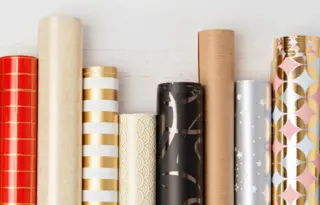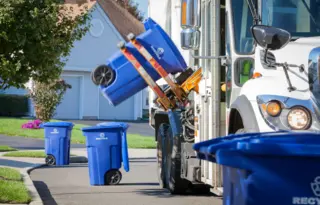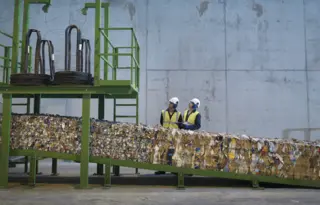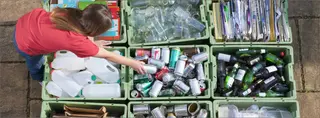
Recycling is a habit that benefits us all, and especially our planet. And while most Americans want to make a habit of recycling, forming good habits can be tough if we don’t have all the information we need.
The easiest way to start is by learning the basics of recycling with paper and cardboard, which are among the most recycled materials in the U.S. By joining the trend, you’re keeping even more of these items out of landfills so that they can be used again to make new products—and that’s something to feel good about.
Here’s a primer to help you begin:
How to Recycle Paper at Home

- Create a recycling center: First, set up a central recycling center. A good spot is in the kitchen, the heart of the home. Some neighborhoods collect all recyclables together, but others require that they be separated by type, such as paper and plastic. If that’s the case in your area, you’ll want a bin for each category of materials you recycle. Next, you’ll want to put bins throughout the house. Those recyclable cardboard boxes that your online orders come in are the perfect for the job: Place one next to trashcans in each room. When a bin is filled, take it to the central recycling center in your kitchen. The best part is you can then put the cardboard box full of recyclables right on the curb for pickup.
- Get creative: Involve everyone in the household, including your kids, and have some fun, like decorating each recycling bin with images of what materials go in them.
- Location, location, location: Where you put the bins matters. Your recycling bins should be readily accessible in the places where you usually dispose of trash. While the garage is common, people with a bin in their kitchen are more likely to have a recycling habit than those with a bin in the garage.
- Have clear guidelines: To help make recycling second nature, post what is and is not recyclable in areas where everyone is sure to see—not just at your recycling center but also in a prominent position such as the refrigerator.

Paper Recycling: What to Collect
The following items are typically accepted, but check your local guidelines to be sure:
- Notebooks
- Catalogs and phone books
- Receipts (unless they have thermal coatings)
- Mail and envelopes: Even those with windows, greeting cards (if they don’t have glitter or foil) and coupons
- White and colored paper: Writing paper, printer paper, file folders and stationery
- Boxes for cereal, shoes, laundry detergent and medicine
- Pizza boxes (even with the stuck on cheese and grease)
- Juice and milk cartons
- Shipping boxes (but be sure to empty and flatten them first)
- Magazines (no need to remove staples or worry about special inks or glossy papers—today’s recycling machinery can handle them)
- Molded pulp packaging (the egg carton type that often secures goods in place within their box)

What Cannot Be Recycled
- Wet paper—put that in the garbage
- Shiny or laminated gift wrap in some locations; check your local recycling rules first
- Paper packaging containing other materials & food
- Paper towels, napkins and toilet paper
*Check your local guidelines to make sure you’re recycling correctly.
rgb(0,164,161)

Where Can I Recycle?
- Join a curbside pickup program. If your neighborhood does not have one, consider reaching out to your local municipality.
- Check local government websites for recycling centers in your area. Some offer drop-off services for a variety of items that curbside programs might not pick up.

How Is Paper Recycled?
- Drivers take recyclable goods picked up from your home to a materials recovery facility, or MRF, where they’re sorted into batches of similar items.
- Often, paper products are pulled first, grouped into categories such as cardboard and office paper, then shipped to mills that turn them into new products up to seven times. Your recycled pizza box, for example, could be made into a cereal box.



